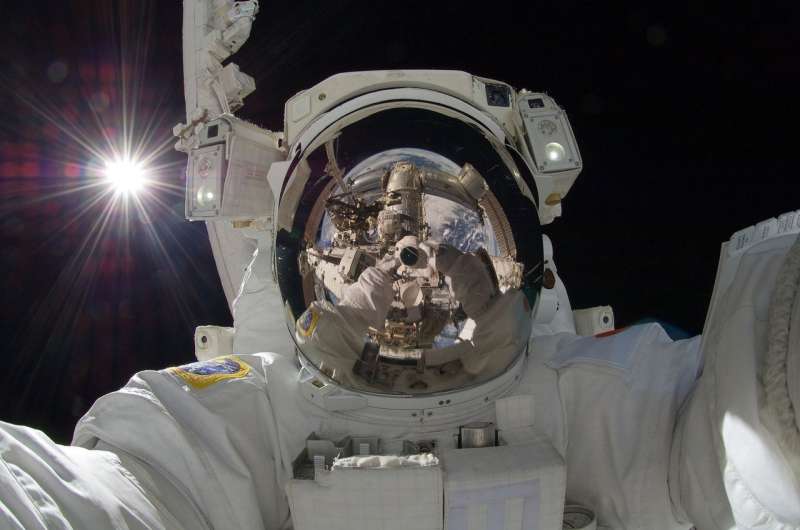Credit: CC0 Public Domain
(Tech Xplore)—Draper researchers have filed a patent that presents a spacesuit solution for guaranteeing astronauts' safety while on their missions. The last thing they would want is to get lost in space.
Their suit would support their way back from their spacewalk to their designated area.
Specifically, Kevin Duda, a space systems engineer at Cambridge, MA-based Draper, has studied astronauts and their habitat onboard the International Space Station.
Duda and colleagues discuss a self-return system to ensure astronauts are safe, even if no other astronaut can rescue them.
"System and method for assisted extravehicular activity self-return" is the patent title; the assignee is listed as Charles Stark Draper Laboratory and the inventors named are Kevin Duda, Richard Loffi and Patrick Handley.
Darrell Etherington, TechCrunch, noted how when triggered by the astronaut, or by another crew member or ground station staff, built-in thrusters of the spacesuit would autonomously guide itself back to a designated safe location.
"It's designed around the challenges of navigating in outer space, where there is no GPS, and it has to take into account conditions that might impact survivability, including remaining oxygen level and fuel available for the thrusters."
Draper noted the astronaut's environment and the risks posed.
"In the zero-gravity environment of space," said Draper, "astronauts can become confused, disoriented."
Even a routine spacewalk can turn dangerous and operating a jetpack can be a challenge: No gravity and no sense of which ways are up and down.
The self-return system by Draper would help astronauts find their way back to the spacecraft more easily.
But wait. Almost impossible to imagine engineers never gave any thought to this risk up to now? This can't be true. The answer is, yes, they thought up manual solutions, but manual may not always work.
Séamus Tuohy said the system is an idea long overdue. He is director of space systems at Draper.
What's the checklist if one wants to engineer a suit with the technology that can help the person find a safe return path? These had to be considered: (1) The self-return system had to be capable of determining a precise location in a no-GPS, harsh space environment. (2) It had to compute a return trajectory that accounts for time, oxygen consumption, safety and clearance requirements and (3) able to guide a possibly unconscious astronaut effectively to safety.
How it works:
The self-return system can be initiated by a space station crew member or mission control or the astronaut. The system can operate the jet pack autonomously. And, it can give the astronaut directions with visual, auditory and sensory cues. The two devices for these cues are sensors and a helmet visor display.
The patent abstract defines the concept as a system and method for assisted EVA self-return. EVA stands for Extravehicular Activity, as in something happening during a spacewalk.
The system computes a guidance trajectory for returning the crewmember to a fixed location. The abstract notes two embodiments—one, the system actuates the crewmember's safety jetpack to follow the trajectory to the location. In another, the system provides the crewmember with a directional cue— visual, auditory, or tactile cue—corresponding to the prescribed trajectory back to the fixed location. "The system may be activated by the crewmember or remotely by another crewmember and/or system."
Actually, beyond astronauts, there are such workers as firefighters, skydivers and others who may benefit from clothing equipped with sensors and other smart technologies.
How so? Draper said, "Applications in the design of navigation systems like Draper's 'take me home' system could serve as an added safety measure for first responders and firefighters as they navigate smoke-filled rooms, skydivers hurtling toward Earth and scuba divers who might become disoriented in deep water."
For example, according to the patent discussion, the "self-return system may be implemented in the suit of a free-falling skydiver and be configured to assist the sky diver in controlling her freefall to land in a desired location if the skydiver became disoriented."
More information: System and method for assisted extravehicular activity self-return, US20170192425A1
© 2017 Tech Xplore























